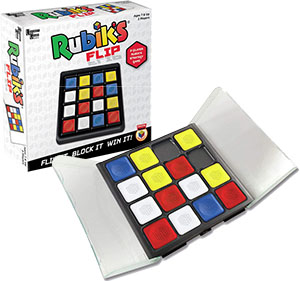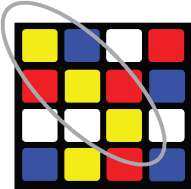

Components
- Game Board (folds for easy storage)
- 8 Red/Blue Rubik's Tiles
- 8 Yellow/White Rubik's Tiles
- instructions
Object of the Game
Have 3 Rubik's Tiles of the same color (all Red, all Blue, all White, or all Yellow) in a "locked" row, either horizontally, vertically, or diagonally.
A row of three is "locked" when none of the game pieces in it can be flipped into an adjacent square because all of the adjacent squares are occupied.

This is the position after both players have played their 8 moves and Yellow/White wins with a "locked" line of 3 Yellow Rubik's Tiles.
Setup
At the beginning of the game, the Game Board is empty.
The storage doors on the sides of the game board, when open, act as trays for holding the Rubik's Tiles. One player takes the 8 Red/Blue Rubik's Tiles and the other takes the 8 Yellow/White Rubik's Tiles.
When not in use, the clear plastic lids snap shut for easy storage so Rubik's Flip can go with you anywhere.

Game Play
-
To determine who gets to go first, players do a "coin toss" with one of the Rubik's tiles.
-
Players alternate taking turns in this game. The player who wins the coin toss starts the game by placing a Rubik's Tile anywhere on the Game Board.
The player may place either color of the Rubik's Tile face up.
-
Flip
(this happens on every turn except for the first Rubik's Tile played):
On player 2's first turn, he/she must first FLIP Player 1's Rubik's Tile already on the Game Board.
Flipping a Rubik's Tile means moving it to any adjacent vacant square (horizontally or vertically, but NOT diagonally) and reversing the Rubik's Tile's color. The Blue Rubik's Tile becomes Red and the White Rubik's Tile flips to become Yellow.
Note: A player must flip an opponent's piece even if this may result in a winning line for the opponent.
If it is not possible to flip any of an opponent's Rubik's Tiles, the player still goes on to place a Rubik's Tile of his or her own in a vacant space on the Game Board.

The Red/Blue player, on their first move, had the option of flipping the White Rubik's Tile into one of four adjacent squares and then placing a Red/Blue Rubik's tile, either side up, anywhere on the Game Board.
-
Place
(After the FLIP):
Each player must, on each turn, then place one of his/her Rubik's Tiles, either side up, on any vacant square on the board, even if this results in a winning line for the opponent.
Play continues with each player first flipping ANY ONE of his or her opponent's Rubik's Tiles (not necessarily the last one placed) before placing a Rubik's Tile of his/her own.
This means that once placed on the Game Board, players will never touch their own Rubik's Tiles, but they may change the position and color of their opponent's Rubik's Tiles.
A player may leave an opponent's row of 3 without losing the game, provided the row is not "locked".

End of the Game
The first player to create a "locked" vertical, horizontal or diagonal line of 3 of his or her own Rubik's Tiles all with the same color is the winner.
A "locked" line is one in which none of the 3 game pieces can be flipped because all adjacent squares are occupied.
If the game continues until the last piece is placed on the board, and both players end up with a winning line, or neither player has won, the game is a DRAW.
Continue Reading


